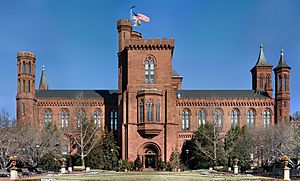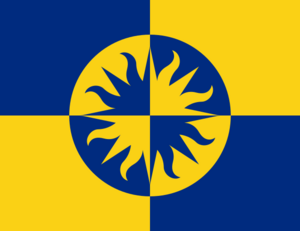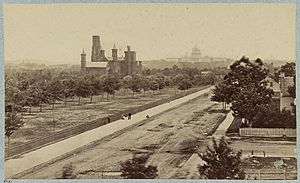Smithsonian Institution facts for kids
 |
|

The Smithsonian Institution Building in Washington, D.C., also known as "the Castle"
|
|
| Established | August 10, 1846 |
|---|---|
| Location | Washington, D.C.; Chantilly, Virginia; New York City; Suitland, Maryland |
The Smithsonian Institution, often just called the Smithsonian, is a special group of museums, education centers, and research places in the United States. It was created by the U.S. government to "increase and diffuse knowledge" – which means to discover and share information with everyone. It started on August 10, 1846.
The Smithsonian has a huge collection of over 157 million items! It includes 21 museums, 21 libraries, 14 education and research centers, and even a zoo. Most of these are in Washington, D.C.. There are also facilities in Maryland, New York, and Virginia. More than 200 other museums across 47 states, Puerto Rico, and Panama are connected to the Smithsonian.
Most of the 30 million people who visit the Smithsonian each year can enter for free. Only the Cooper Hewitt, Smithsonian Design Museum in New York City charges a fee. The Smithsonian gets most of its money from the government. It also gets funds from donations and its own earnings.
Contents
How the Smithsonian Started

The idea for the Smithsonian began with a group of people in Washington in 1816. They wanted to create an organization to share useful knowledge. This group, called the Columbian Institute, worked to study plants, minerals, and improve farming. They also wanted to create a botanical garden and a museum. Some of their museum items were later given to the Smithsonian.
The Smithsonian was made possible by a generous gift from a British scientist named James Smithson. He passed away in 1829 and left most of his money to his nephew. When his nephew died without children in 1835, Smithson's will said the money should go to the United States. He wanted it to create an "Establishment for the increase & diffusion of knowledge among men" in Washington.
In 1838, an American diplomat brought 105 bags of gold coins from Smithson's estate to the U.S. This was about $500,000 at the time, which was a huge amount of money.
It took eight years for the U.S. Congress to decide how to use Smithson's gift. The money was even lost for a while when the state of Arkansas defaulted on bonds where it was invested. But a former president, John Quincy Adams, convinced Congress to get the money back and use it for science and learning. Finally, on August 10, 1846, President James K. Polk signed the law that officially created the Smithsonian Institution. It was set up to be managed by a special group called the Board of Regents and a secretary.
Growing Over Time

The first leader of the Smithsonian, Joseph Henry, wanted it to be a place for scientific research. But it also became a storage place for many collections from the U.S. government. For example, the U.S. Navy explored the world from 1838 to 1842. They collected thousands of animal and plant specimens, shells, minerals, and artifacts from the South Pacific. These items became part of the Smithsonian's growing collections.
The Smithsonian also played a key role in studying weather and became a popular place for young scientists.
Museums and Buildings
The first building for the Smithsonian, known as "the Castle," started being built in 1849 and opened in 1855. It was designed by James Renwick Jr..
Over the years, many more museums and buildings were added:
- The Arts and Industries Building opened in 1881.
- The National Zoo opened in 1889 to house the Smithsonian's live animals.
- The National Museum of Natural History opened in 1911. It holds many of the Smithsonian's natural history items.
- The Freer Gallery of Art opened in 1923, thanks to a large donation from Charles Lang Freer.
- The National Museum of American History opened in 1964.
- The Anacostia Community Museum opened in 1967 in Washington, D.C.
- The National Portrait Gallery and the Smithsonian American Art Museum opened in 1968 in an older building.
- The Renwick Gallery opened in 1972, also in an older building.
- The Hirshhorn Museum and Sculpture Garden opened in 1974.
- The National Air and Space Museum, one of the largest, opened in 1976.
- The National Museum of African Art and the Arthur M. Sackler Gallery opened together in 1987.
- The National Postal Museum opened in 1993 in a former post office building.
- The National Museum of the American Indian opened in 2004.
- The newest museum, the National Museum of African American History and Culture, opened in 2016.
Two more museums are being planned for the future: the National Museum of the American Latino and the Smithsonian American Women's History Museum.
Raising Money
In 2011, the Smithsonian started its first big fundraising campaign. They aimed to raise $1.5 billion. By 2017, they had raised over $1.79 billion! This money helped build new museums, renovate old ones, and digitize collections so more people could see them online.
The Smithsonian has also used online fundraising platforms like Kickstarter. For example, they raised money to help preserve the famous ruby slippers from The Wizard of Oz movie.
Smithsonian Museums

The Smithsonian has 19 museums and galleries, plus the National Zoo. Many of them are located on the National Mall in Washington, D.C. Others are in different parts of Washington, D.C., New York City, and Chantilly, Virginia.
| Institution | Type of collection | Location | Opened | |
|---|---|---|---|---|
| Anacostia Community Museum | African American culture | Washington, D.C. Anacostia |
1967 | |
| Arthur M. Sackler Gallery (affiliated with the Freer Gallery) | Asian art | Washington, D.C. National Mall |
1987 | |
| Arts and Industries Building | Special event venue | Washington, D.C. National Mall |
1881 | |
| Cooper Hewitt, Smithsonian Design Museum | Design history | New York City Museum Mile |
1897 | |
| Freer Gallery of Art (affiliated with the Sackler Gallery) | Asian art | Washington, D.C. National Mall |
1923 | |
| Hirshhorn Museum and Sculpture Garden | Contemporary and modern art | Washington, D.C. National Mall |
1974 | |
| National Air and Space Museum | Aviation and spaceflight history | Washington, D.C. National Mall |
1946, 1976 |
|
| National Air and Space Museum's Steven F. Udvar-Hazy Center | Aviation and spaceflight history | Chantilly, Virginia | 2003 | |
| National Museum of African American History and Culture | African-American history and culture | Washington, D.C. National Mall |
2003, 2016 |
|
| National Museum of African Art | African art | Washington, D.C. National Mall |
1964, 1987 |
|
| National Museum of American History | American history | Washington, D.C. National Mall |
1964 | |
| National Museum of the American Indian | Native American history and art | Washington, D.C. National Mall |
2004 | |
| National Museum of the American Indian's George Gustav Heye Center | Native American history and art | New York City Bowling Green |
1994 | |
| National Museum of Natural History | Natural history | Washington, D.C. National Mall |
1858, 1911 |
|
| National Portrait Gallery | Portraiture | Washington, D.C. Penn Quarter |
1968 | |
| National Postal Museum | United States Postal Service; postal history; philately | Washington, D.C. NoMa |
1993 | |
| Renwick Gallery | American craft and decorative arts | Washington, D.C. Lafayette Square |
1972 | |
| Smithsonian American Art Museum | American art | Washington, D.C. Penn Quarter |
1968 | |
| Smithsonian Institution Building (The Castle) | Visitor center and offices | Washington, D.C. National Mall |
1855 | |
| National Zoological Park (National Zoo) | Zoo | Washington, D.C. Rock Creek Park |
1889 | |
| Smithsonian American Women's History Museum | Women's history | Washington, D.C. |
2020 | |
| National Museum of the American Latino | Hispanic and Latino Americans | Washington, D.C. |
2020 |
The Smithsonian also works closely with 168 other museums across the U.S., Panama, and Puerto Rico. These are called Smithsonian Affiliates. The Smithsonian lends artifacts to these museums for long periods. It also has many traveling exhibitions that visit different places.
Amazing Collections
The Smithsonian's collections include 156 million artworks, artifacts, and specimens. The National Museum of Natural History alone holds 145 million of these, mostly preserved animals. You can find 9.9 million digital records of items online. The Smithsonian Libraries have 2 million books.
Some of the most famous items you can see at the Smithsonian museums include:
- The First Ladies' Gowns display at the National Museum of American History.
- The original Star-Spangled Banner flag.
- The stovepipe hat worn by President Abraham Lincoln.
- The ruby slippers worn by Judy Garland in The Wizard Of Oz.
- The original Teddy Bear, named after President Theodore Roosevelt.
- A large model of the Enterprise spaceship from the original Star Trek TV series.
In recent years, the Smithsonian has adopted a new policy about returning items. This means they can return items that were collected in ways that are now considered unfair. For example, in 2022, the National Museum of African Art returned many Benin Bronzes to Nigeria.
Open Access to Knowledge
In February 2020, the Smithsonian made 2.8 million digital items available online for anyone to use for free. They plan to release even more items in the future. This helps spread knowledge, just as James Smithson wanted!
Research Centers
The Smithsonian has eight research centers in different locations. These centers focus on various areas of study. For example, the Smithsonian Astrophysical Observatory studies space, and the Smithsonian Environmental Research Center studies coastal ecosystems. The Smithsonian Libraries and Archives, which used to be separate, joined together in 2020 to form one research center.
| Research center | Area of focus | Location | Opened | |
|---|---|---|---|---|
| Archives of American Art | History of the visual arts in the United States | Washington, D.C. New York City |
1954 1970 |
|
| Smithsonian Astrophysical Observatory | Astrophysics (study of space) | Cambridge, Massachusetts | 1890 | |
| Museum Conservation Institute | Conservation (preserving old items) | Suitland, Maryland | 1965 | |
| Smithsonian Conservation Biology Institute (affiliated with the National Zoo) | Studying and protecting animals | Front Royal, Virginia | 1974 | |
| Smithsonian Environmental Research Center | Coastal ecosystems (natural environments) | Edgewater, Maryland | 1965 | |
| Smithsonian Libraries and Archives | Information about science, art, history, and museums | Washington, D.C. | 1968 2020 |
|
| Smithsonian Marine Station at Fort Pierce (affiliated with the National Museum of Natural History) | Marine life and environments in Florida | Fort Pierce, Florida | 1981 1999 |
|
| Smithsonian Tropical Research Institute | Tropical ecology (study of tropical environments) | Panama | 1923 1946 1966 |
Cultural Centers
The Smithsonian Institution also has three cultural centers:
- Center for Folklife and Cultural Heritage
- Smithsonian Asian Pacific American Center
- Smithsonian Latino Center
Smithsonian Latino Center
The Smithsonian Latino Center was created in 1997. Its main goal is to highlight the contributions of Latino people to arts, history, science, and culture across all the Smithsonian's museums and research centers.
The center works to support research, exhibitions, and educational programs. It also helps young Latino students and museum professionals develop their leadership skills. Today, its website has a cool virtual museum where you can take tours of past and present exhibits.
Young Ambassadors Program
One special program at the Latino Center is the Young Ambassadors Program (YAP). This program helps Latino high school students become leaders in arts, sciences, and humanities.
Students chosen for YAP travel to Washington, D.C., for a special seminar. After that, they return to their hometowns for a paid internship. The program encourages students to be proud of their heritage and teach others about how Latinos enrich American culture.
Awards Given by the Smithsonian
The Smithsonian gives out several awards to recognize important work:
- The James Smithson Medal is the highest award. It's given for amazing contributions to art, science, history, education, and technology.
- The James Smithson Bicentennial Medal is for people who have greatly helped areas the Smithsonian cares about.
- The Hodgkins Medal is for important discoveries about our physical environment.
- The Henry Medal is for people who have done great service or helped the Smithsonian grow.
- The Langley Gold Medal is for important studies in flight and aviation.
How the Smithsonian is Managed
The Smithsonian Institution is a special organization created by the U.S. Congress. Most of its 6,300 employees work for the federal government. The Smithsonian also has its own police force to keep its facilities safe.
The Smithsonian's exhibits are free to visit. The organization is governed by a group called the Board of Regents, which has 17 members. This board includes important people like the Chief Justice and the Vice President. The Chief Justice usually serves as the head of the institution.
The main leader of the Smithsonian is called the Secretary. The current Secretary is Lonnie Bunch, who started in 2019. He used to be the founding director of the National Museum of African American History and Culture.
|
See also
 In Spanish: Institución Smithsonian para niños
In Spanish: Institución Smithsonian para niños




